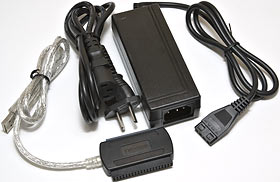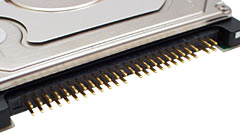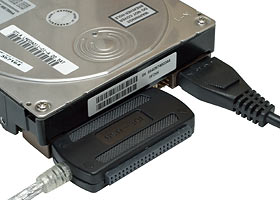
R-Driver II USB to IDE cable
Review date: 30 January 2005. Last modified 03-Dec-2011.
As regular readers will know, I have a certain enthusiasm for plug-and-go gadgets that turn ATA (IDE) devices into USB ones, or do related interface-bending tricks.
Not that I make a religion out of them, or anything. I realise that a simple external drive box is a much better, and not necessarily any more expensive, option if you want semi-permanent transportable storage. But it's still cool that devices exist that let you turn a nude ATA drive into a USB storage device in, literally, seconds.
These things are handy low-level geek tools for those moments when, y'know, you've got this machine in pieces for a motherboard upgrade, and you've just realised there's stuff on its drive that you need to access on that machine, and you don't want to shut that machine down and take the side off and unplug one of its drives (because its ATA cables are fully populated, of course) and push the cases together and string a ribbon cable across the gap, or unscrew this machine's drive and sit it on some cardboard in the bottom of that machine's casing, then boot that machine again, just to get those 27 stupid kilobytes of data.
With a USB-IDE cable, you can power up a drive by itself whether it's screwed into a PC or not, hot-plug it into another running computer, shift your data (well, possibly after a brief stop in Disk Management to import the foreign disk, if you're running a recent Windows flavour), unplug it again, and get on with your day.
You get the idea.
And if you want a hardcore-looking carry-around drive, no problem. Grab that old 0.2-times-the-current-maximum-available-capacity unit off the Components I Don't Trust Any More shelf, tape it up good, stick it in your backpack along with a USB-to-IDE cable, and hit the road feeling all Gibsonian.
This stab at the USB-IDE cable concept is, according to the box, called the "R-Driver II". USB Geek leave that name out of their product page for the gadget, which they sell for only $US35. Plus three US bucks for delivery anywhere in the world. No matter how much stuff you order. I kid you not.
I checked out another such device from USB Geek a while ago. That one cost $US32, and had a bit more personality than I liked. For the extra three bucks, the R-Driver II gives you more features, and less weirdness.
It's essentially the same thing as the other USB-IDE cable. One data cable for your drive and your USB port, one power adapter.
The data cable enters the IDE-plug end from the side, for reasons that'll become clear in a moment. I am happy to say that the R-Driver design department are not a bunch of cretins; the cable entry is on the other side from the place where you'll be putting the power plug.
The R-Driver II is USB v2.0 compatible, of course. It works with USB 1.1 as well, but then you're not likely to quite be able to shift even one megabyte of data per second, at which speed your 300 gigabyte fansubbed anime collection will take four days to copy.
The power adapter cable terminates in a four pin "Molex" connector. Only three of the Molex plug pins are connected, but that's OK; the two middle pins are redundant earths to reduce resistance. They're connected together on all drive circuit boards, and when you're just running a single drive it's fine to cut costs by only connecting one pin.
The R-Driver package also, by the way, contains a 77mm mini-CD driver disc, which may be of use to Win98 users, or may not; my devotion to journalistic excellence is insufficient for me to bother checking. Everyone using vaguely recent versions of Windows or Mac OS shouldn't need any extra drivers to use any modern ATA/USB adapter; USB storage drivers are built into the operating system. Linux ought not to be a problem either, but that depends on the bridge hardware chipset in the adapter cable, the Linux version you're using, and possibly also the thread count of your bedsheets.
The R-Driver's Unique Selling Point is that on the other side of its standard 40 pin data plug is... another plug.
This is a 44 pin ATA plug, as used on 2.5 inch laptop drives (find the pinout, and many others, here).
There are more than 44 pins on the back of a 2.5 inch drive, but the extra four in a separate block to the right of the main bunch of 44 are "vendor specific" and do, to a first approximation, nothing. The four rightmost pins of the laptop connector carry power. Since laptop drives don't need much power, a powered USB port should be enough to run them (so, not a port on a "bus powered" USB hub without its own separate power adapter; any powered hub or "root port" on a PC or laptop should be OK).
Oh, and I know what you're thinking: No, you can't plug in two drives at once.
Hooking up
Connecting the R-Driver II is as simple as connecting any other USB-IDE widget, unless you're hooking it up to a laptop drive, whereupon it's even simpler because you don't need the power adapter. Connect data cable to drive, connect power cable to drive, wait for drive to spin up, plug USB lead into computer. The USB lead's only a couple of feet in length, but you can use an extension lead with it if that's not enough.
As long as the drive you're connecting to is set to Master (does anyone else remember the days when some drives didn't have jumper block settings on their spec stickers? Wasn't that fun?), the data side is plug-and-go. The power side's about as simple; the R-Driver power adapter is a world-compatible unit, and it's got a standard IEC socket on it, so you can use any spare computer power lead you've got lying around to run it.
If you don't happen to have a spare IEC lead, make sure you get your R-Driver with the right kind of power cable. As with the last adapter I checked out, USB Geek give you the choice of three different power cables for the R-Driver, none of which is the Australian "/ \" kind. But you can always plier-twist the pins of a US-style "| |" plug to fit an Australian socket. Try to make sure you've got an audience.
I'm happy to say that the R-Driver II power supply connector actually worked as intended without any extra, um, stationery, unlike the older one.
After hooking up the R-Driver II, I discovered that despite appearances, it's actually got an activity LED. The LED's under the thin logo stamping in the middle of the plastic casing; you can only see it dimly (it'll be invisible in a brightly lit room), but I guess it's better than nothing.
Testing
For USB 2 writes of large files using the same undistinguished 120Gb test disk I used for the last adapter cable, the R-Driver II was for some reason slightly slower. It managed only about 17.5 megabytes per second write speed, and around 19.5Mb/s read speed, in highly non-laboratory conditions. The older adapter managed 23 to 25Mb/s, which for a hundred gigabytes of data means waiting about 70 minutes, as opposed to about 90 for the R-Driver II (300Gb fansubbed anime collection at 17.5Mb/sec: Less than five hours). You may or may not care about this.
Personally, I've got no problem with a bit less speed, as long as I'm still getting plenty more than USB 1.1 can deliver.
USB-IDE devices (both bare cables and enclosures) have, however, a lousy record of compatibility with optical disc writers.
If all you want to do is read CDs and DVDs, you're likely to be fine with any USB-IDE gadget. If you want to burn discs, though, old USB-IDE gadgets often didn't work at all, and current ones are commonly still quirky. The last USB Geek adapter cable was OK for DVD burning, but only at 2X speed. 4X didn't fly.
This time, I tested the cable with a humble CD burner. Drive detection worked perfectly, just appending "USB Device" to the end of the drive's actual name; that's a good sign. And, lo and behold, 32X burning also worked. And that's the same thing, data-rate-wise, as 4X DVD burning.
Well, more or less. Depending on who you ask.
Classically, you see, "1X" DVD speed should be 1353 kilobytes per second - which makes 32X CD burning, at a theoretical 32 times 150 kilobytes per second, about 3.5X DVD speed.
The actual data rate of DVD video varies, though. DVD burner manufacturers therefore have a certain amount of number-fudging carte blanche when it comes to putting "X" figures on their products. The Billy Connolly disc I watched last night has nearly two hours and 22 minutes of video on it, but only 3965Mb of data including the menus. Its data rate is therefore only around 470 kilobytes per second - and yes, the backdrops behind Billy do look rather crunchy as a result.
A manufacturer really dedicated to lying, therefore, could use low bit rate DVDs like these as their benchmark and then say that their 1353 kilobyte per second burner wasn't only 1X, but was actually almost 3X.
Manufacturers who stick with moderate degrees of exaggeration, however, can fairly describe a 32X-CD-speed-DVD-burner as 4X, thanks to CAV and CLV, which I've written about, along with the 52X speed limit, before. And this USB-IDE adapter can handle that, at least.
Diversion concludes. Thank you for your indulgence.
Overall
It's nice to see one of these things that performs as advertised, with no nasty surprises. Well, the adapter I got had no problems, anyway; with cheap gear like this, I'm loath to make promises.
Speaking of cheap - USB Geek also sell a version of this kit with no power adapter. It's for people who only want to use it with 2.5 inch drives, or who're happy to plug 3.5 inch devices into a regular PSU. It costs a mere seventeen US dollars.
If your computer's ATA controller's full up and you don't want to install another controller card (or don't have a slot for it), the no-power adapter offers a neat way out; you could thread the USB cable through a back panel hole to a drive mounted inside the PC and connected to the PSU as normal. I've done stuff like that - usually with drives sitting loose inside the case and insulated from the metal with a piece of paper. Professional Installations 'R' Us.
Most computer users will not for the life of them be able to think of a reason why they'd need a thing like the R-Driver II. If you do need a USB-IDE cable, though - or if you just reckon that $US38 including shipping isn't a bad price to pay for a thing that may come in very handy one day - then the R-Driver II gets the job done well.
Recommended.
Review R-Driver II kindly provided by USB Geek.






